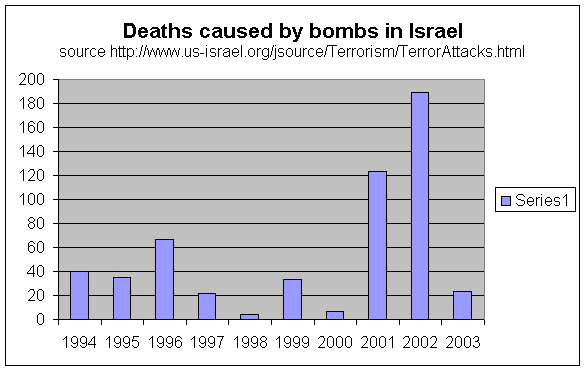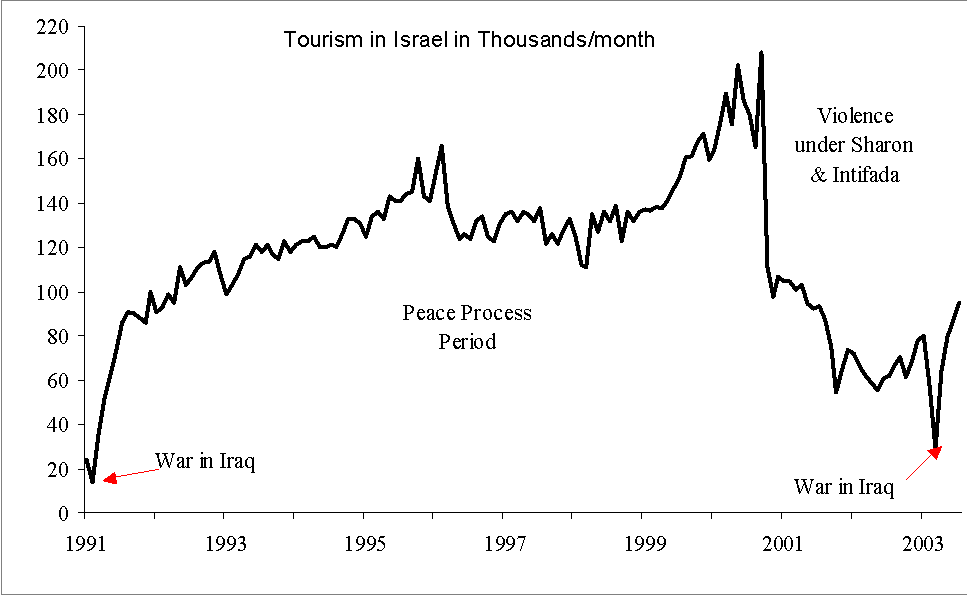|
|
|
|
|
| Israel | Palestine | US | Arabia | ROW |
| Withdrawal | Peace | Aid | Peace | Support |
| Occupation | Intifada | Aid | Blockade | Ostracize |
| Expulsion | War | Cover | War | Ostracize |
| Election | Peace | Incorporation | Normalize | Support |
| Abandonment | Conquest | Ignore | Normalize | Ignore |
| Genocide | War | Withdraw | War | Ostracize |
| Binational | Conquest | Aid | Normalize | Support |
The current "cold war" equilibrium (line 2) comprises Israeli military occupation and creeping settlement expansion, all funded by America (partly as corporate welfare for US military industry), Palestinian active resistance and monkey-wrenching by terror, an economic blockade by most of Arabia, and increasing ostracism by the ROW.
Many believe a new equilibrium is possible, that if Israel accepts "two states for two peoples" by withdrawing to 1967 Green Line, the Palestinians would move into peaceful compromise, Arabia would lift its blockade, and ROW acceptance of Israel would increase.(Line 1) Such peace is a stated diplomatic aim of the US, but internal politics prevent it from using its aid as leverage or lowering the corporate welfare payment.
The Israeli right-wing seeks to maximize land, and publicly advocates a "one state solution" with expulsion of the Arab majority under the "Benny Elon Peace Plan". While this ethnic cleansing of the state is technically shy of genocide, it would likely lead to total war and full international isolation. In fact, it may be that Israel's security depends on hiding behind the civilian shield of its Arab population, which if it dropped below 10% would remove inhibitions against war.
The Palestinian Left (and international communism) also call for a one state solution. This "Democratic Bi-national State" is code for the dilution of the Jewish majority in Israel by absorbing the growing Arab population. While short of a military conquest of Israel to maximize Palestine land and "return", an Arab population of more than 40% is a "poison pill" for a majority of Israelis.
Israel as the 51st state is not yet seriously discussed, as it means an end to the Zionist dream, but has even been proposed by Rabbi/Popstar Boteach. It would allow the retention of a secular government providing religious freedom to the Jewish majority and Muslim and Christian minorities. The threat of war against a US state is zero.
Several attempts have been made to move out of the current painful equilibrium. For example, the military attack of 9/11 on the US that apparently emanated from somewhere in Arabia moved the US into war with some enemies of Israel, and is consistent with line 3. Many people feared Israel would use this to accelerate annexation, and, indeed, both settlements and a "fence" have been accelerated under increased US aid after 9/11.
The Peace Process, formerly known as Oslo, moved Palestine from the Intifada play to a non-violent "Gandhi" position for 7 years, as people optimistically awaited the final agreement which would lead to Palestinian self-determination. Both economies picked up dramatically, including a 10X growth in Israeli tourism, but benefits to the Palestine people were inhibited by Israel's importation of foreign workers and by corruption. In some way, the improvement in strength of both sides led to arrogance in negotiations which drove the game back to the Occupation/Intifada equilibrium.
Although many believe that "Oslo failed," numbers
seem to tell a story that violence decreased continuous while
there was hope for peace. The following graph of Israeli deaths
from suicide bombings from 1993-2003 illustrates that terror
consistently declined during the Oslo period. The spikes in 1996
and 1999 can be attributed to specific events rather than random
violence. In February 1996, there was a suicide bombing (26)
to mark the anniversary of Baruch Goldstein's massacre, followed
by a PA crackdown which lead to more bombings in March (39);
On Nov 7 1999 a pipe bomb attack (27) undermined the most optimistic
moment of Oslo - a meeting between Clinton and Arafat. There
was no claim of responsibility for the pipe bomb.
This graph of data from the Israeli Ministry of Finance plots visits to Israel by tourists.

Unfortunately, the scientific power of using focus groups to develop "language" delivered by charismatic personalities, repeated by leaders, or as news through covert channels to affect public opinion, enables players to manipulate the balance and mix of strategies both domestically and internationally. In the US, the claims of Iraqi WMD's may be seen not as "bad intelligence" but as PR which was highly effective at getting the public to support an invasion.
Such Psyops can affect the mixture of strategies by manipulating masses perception of utility, rather than utility itself. Generally any appeal that the other side is irrational, and will act against its own interests, are in fact signals that the communication is meant to affect perception of utility. The belief that Oslo lead to an increase in suicide bombs rather than the lowering of violence and increase in tourism is implanted. The Palestinean belief that the Right of Return is absolute, or that suicide is heroic, are similarly implanted beliefs. This very article may be seen in this light as an attempt to affect perception of the utility of peace.
Because of the mixed-strategy nature of the Middle East game and the sensitivity of populations to psychological operations, it could actually be in the self-interest of various subgroups to fund "vocal" groups on the other side. For fundraising in support of Israel, the more Palestinians calling for the its destruction, the better. For the Left, the prominent moderates and intellectuals demonstrate there is someone to talk to. Assassinations which cause revenge suicide bombs serve to strengthen the militaristic approach. Even the creation of Palestinian groups like Hamas which advocate violent destruction of Israel may have served Israel's interest in disunifying Palestinian politics. Similarly both "one state" solution proponents (Explusionists, and "democratic bi-nationalism") share payoffs in the game.
Finally, the Geneva Accord, which is a precise expression of the final settlement anticipated by the peace process, is funded by the ROW, and attempts to try to reunite centrist public opinion behind again attempting to find a less bloody equilibrium in the conflict. The mailing of booklets to all homes, the large signing affair in Geneva, are all basically information signals, since the current Israeli government makes moves consistent with expulsion.
In conclusion, once factions seeking expansion and expulsion are factored in, and looking at public opinion as changeable via psychological operations, it is possible through a game theoretic framework to understand the cycle of violence as having a utility, namely to drive both Israel and Arab public opinion away from the known compromise which would terminate one-state plans.
It seems clear that only a very strong and sustained external stimulus could overcome the equilibrium and drive public opinion back to the consensus that peace is possible, and to architect the public and social infrastructure for a peaceful Palestinian state. This may include investing in large scale mutually-beneficial public works projects (rather than a fence) such as desalinization plants and highways, setting up a multinational peace-keeping force, or leadership by the US.